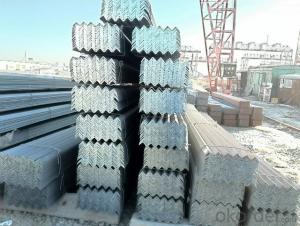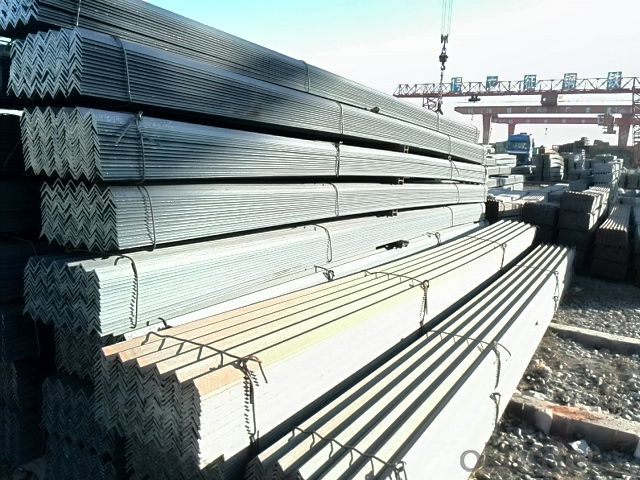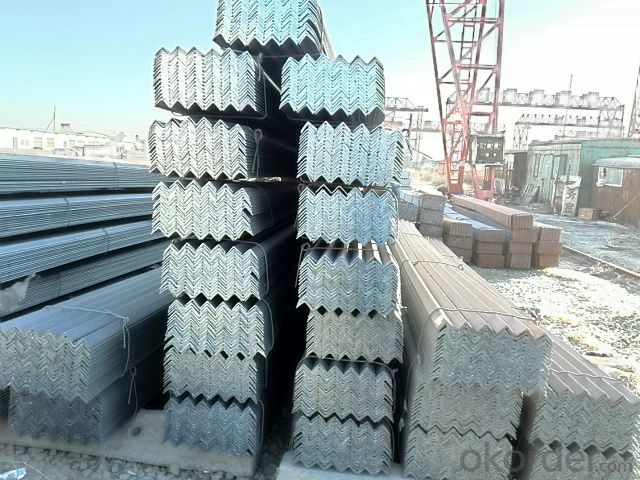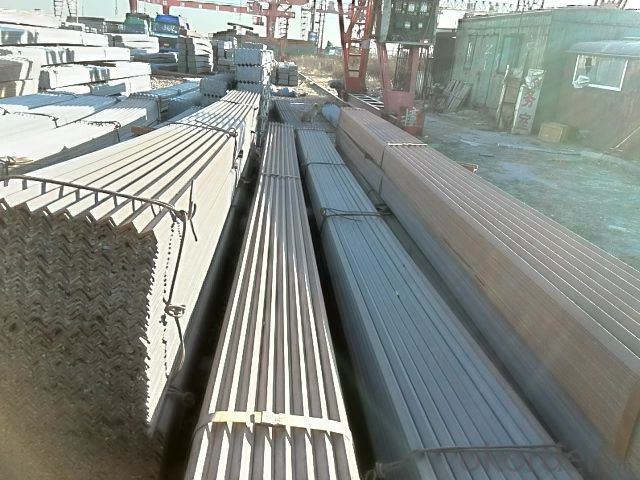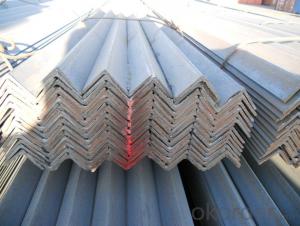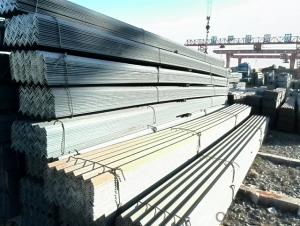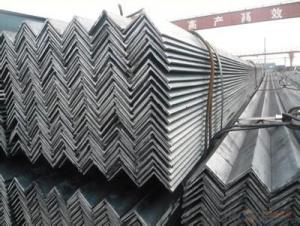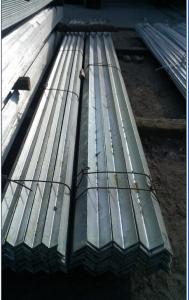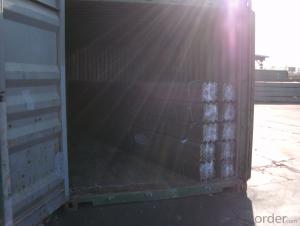Hot Rolled Steel angles in Material Grade Q235
- Loading Port:
- Tianjin
- Payment Terms:
- TT OR LC
- Min Order Qty:
- 25 m.t
- Supply Capability:
- 10000 m.t/month
OKorder Service Pledge
OKorder Financial Service
You Might Also Like
OKorder is offering Hot Rolled Equal Angles at great prices with worldwide shipping. Our supplier is a world-class manufacturer of steel, with our products utilized the world over. OKorder annually supplies products to European, North American and Asian markets. We provide quotations within 24 hours of receiving an inquiry and guarantee competitive prices.
Product Applications:
Hot Rolled Equal Angles are ideal for structural applications and are widely used in the construction of buildings and bridges, and the manufacturing, petrochemical, and transportation industries.
Product Advantages:
OKorder's Hot Rolled Equal Angles are durable, strong, and resist corrosion.
Main Product Features:
· Premium quality
· Prompt delivery & seaworthy packing (30 days after receiving deposit)
· Corrosion resistance
· Can be recycled and reused
· Mill test certification
· Professional Service
· Competitive pricing
Product Specifications:
Manufacture: Hot rolled
Grade: Q195 – 235
Certificates: ISO, SGS, BV, CIQ
Length: 6m – 12m, as per customer request
Packaging: Export packing, nude packing, bundled
Sizes: 25mm-250mm | ||
a*t | ||
25*2.5-4.0 | 70*6.0-9.0 | 130*9.0-15 |
30*2.5-6.6 | 75*6.0-9.0 | 140*10-14 |
36*3.0-5.0 | 80*5.0-10 | 150*10-20 |
38*2.3-6.0 | 90*7.0-10 | 160*10-16 |
40*3.0-5.0 | 100*6.0-12 | 175*12-15 |
45*4.0-6.0 | 110*8.0-10 | 180*12-18 |
50*4.0-6.0 | 120*6.0-15 | 200*14-25 |
60*4.0-8.0 | 125*8.0-14 | 250*25 |
FAQ:
Q1: Why buy Materials & Equipment from OKorder.com?
A1: All products offered byOKorder.com are carefully selected from China's most reliable manufacturing enterprises. Through its ISO certifications, OKorder.com adheres to the highest standards and a commitment to supply chain safety and customer satisfaction.
Q2: How do we guarantee the quality of our products?
A2: We have established an advanced quality management system which conducts strict quality tests at every step, from raw materials to the final product. At the same time, we provide extensive follow-up service assurances as required.
Q3: How soon can we receive the product after purchase?
A3: Within three days of placing an order, we will begin production. The specific shipping date is dependent upon international and government factors, but is typically 10 to 30 workdays.
Images:
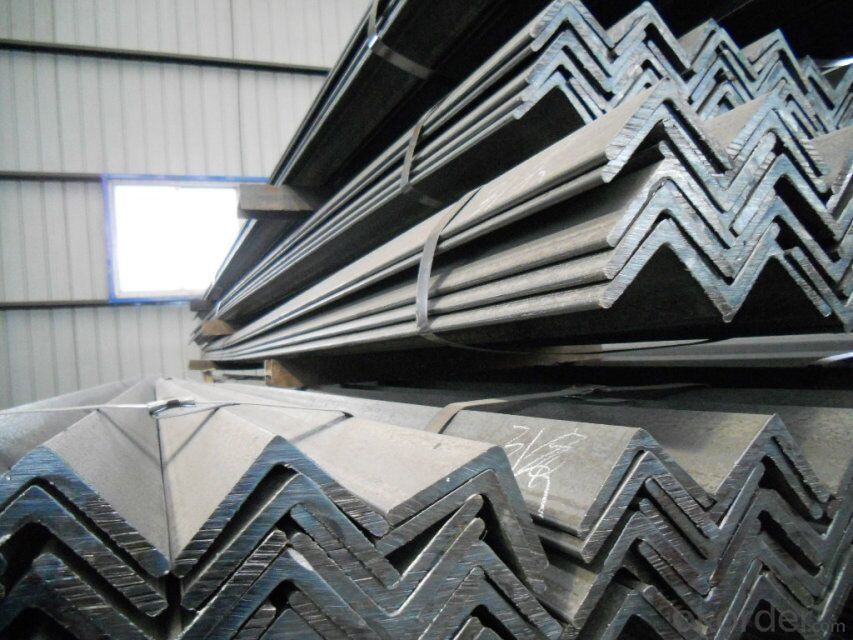
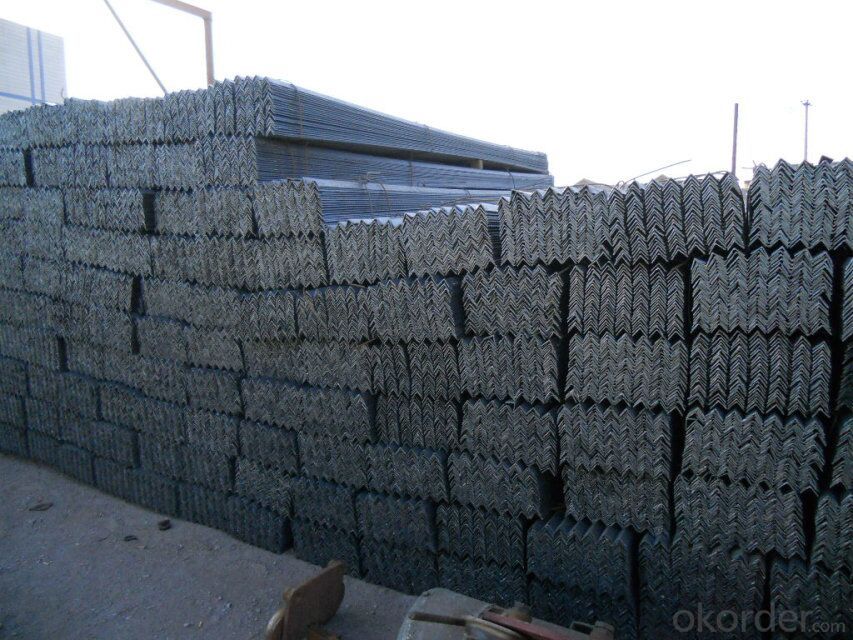
- Q: Can steel angles be customized or fabricated to specific requirements?
- Steel angles have the ability to be customized or fabricated according to specific requirements. With their versatility, steel angles can easily be modified to meet a variety of specifications and applications. Various fabrication processes, such as cutting, drilling, welding, and bending, can be employed to tailor steel angles to the desired shape, size, and dimensions. This enables the creation of steel angles with specific lengths, thicknesses, and angles, satisfying the unique demands of construction or engineering projects. Customized steel angles find utility in numerous applications, including structural framing, supports, brackets, reinforcements, and architectural designs. In summary, the flexibility of steel angles in customization and fabrication makes them highly suitable for meeting a wide range of construction and industrial needs.
- Q: Can steel angles be used for electrical conduits or cable trays?
- Steel angles can be used for electrical conduits or cable trays depending on the specific requirements and regulations of the project. Steel angles are commonly used as structural supports and are known for their strength and durability. However, when considering their use for electrical conduits or cable trays, it is important to ensure that they meet the necessary electrical and safety codes. Electrical conduits and cable trays are designed to safely house and protect electrical wires or cables. These systems need to be able to withstand the weight of the cables, provide proper grounding, and offer adequate protection against physical damage or exposure to moisture or other hazards. Steel angles can be used as support structures for electrical conduits or cable trays, providing a sturdy framework for mounting and securing the system. However, it is crucial to ensure that the steel angles are properly grounded, insulated, and protected against corrosion to meet electrical safety standards. Additionally, the specific size and dimensions of the steel angles should be chosen based on the weight and size of the cables or wires being installed. It is important to consult with electrical engineers or professionals familiar with local electrical codes and standards to ensure that the steel angles meet all necessary requirements. In conclusion, steel angles can be used for electrical conduits or cable trays, but it is essential to consider the specific requirements and regulations of the project to ensure electrical safety and compliance.
- Q: Can steel angles be used in earthquake-prone areas?
- Yes, steel angles can be used in earthquake-prone areas. Steel angles are commonly used in construction due to their strength and ability to resist seismic forces. They can be incorporated into the design of buildings and structures to provide added stability and support during earthquakes. However, it is essential to ensure that the steel angles are properly designed and installed according to the seismic design codes and regulations of the specific region to ensure maximum safety.
- Q: How do steel angles perform under dynamic loads?
- Steel angles generally perform well under dynamic loads due to their inherent strength and durability. The structural shape of steel angles, characterized by their L-shaped cross-section, provides excellent resistance to bending and torsional forces. This design allows them to efficiently distribute dynamic loads and resist deformation, making them suitable for various applications in construction, engineering, and manufacturing industries. However, the specific performance of steel angles under dynamic loads can vary depending on factors such as the grade and quality of the steel, the magnitude and frequency of the dynamic load, and the overall design and reinforcement of the structure.
- Q: Can steel angles be cold-formed or bent to specific shapes?
- Yes, steel angles can be cold-formed or bent to specific shapes. Cold forming is the process of reshaping a metal without the use of heat, typically through methods such as bending, rolling, or pressing. Steel angles, which are L-shaped structural components made of steel, can be cold-formed to achieve various shapes and angles as per the specific requirements of a project. This process involves applying force and pressure to the steel angle, causing it to deform and take on the desired shape. Cold forming steel angles allows for flexibility in design and customization while maintaining the strength and durability of the steel.
- Q: What is the bending capacity of a steel angle?
- The ability of a steel angle to withstand bending or flexing without breaking or deforming excessively is known as its bending capacity. This capacity reflects the angle's structural strength and is typically influenced by factors such as the angle's dimensions, thickness, type of steel, and presence of any additional reinforcements or supports. To determine the bending capacity, it is common to express it as the maximum load or stress that the angle can endure before it permanently deforms at its yield point. The bending capacity of a steel angle can vary significantly based on these factors, and it is of utmost importance to consider this capacity during the design and construction of structures that incorporate steel angles to ensure their structural integrity and safety.
- Q: Are steel angles suitable for high-rise buildings?
- Steel angles, otherwise referred to as L-shaped structural steel, are a fitting choice for the construction of high-rise buildings. This is primarily due to their robustness and adaptability. In particular, they provide essential support and stability to the building, particularly in cases where there is a need to transfer both vertical and horizontal loads. Moreover, steel angles possess a remarkable ability to withstand substantial stress and can easily be tailored to meet specific building requirements. Furthermore, they are cost-effective and possess a notable strength-to-weight ratio, rendering them highly suitable for high-rise construction endeavors. Ultimately, steel angles possess the vital attributes of strength, endurance, and versatility that are indispensable in the construction of high-rise buildings.
- Q: How are steel angles protected against rusting?
- Steel angles are protected against rusting through a process known as galvanization. Galvanizing involves coating the steel angles with a layer of zinc. This zinc coating acts as a barrier between the steel and the surrounding environment, preventing moisture and oxygen from coming into contact with the steel surface. As a result, the steel angles are protected from rusting. Galvanized steel angles are commonly used in outdoor applications or in environments where they may be exposed to moisture, such as in construction, infrastructure, or manufacturing industries. Additionally, regular maintenance and proper storage of steel angles can also help prolong their protection against rusting.
- Q: Can steel angles be used for conveyor systems?
- Yes, steel angles can be used for conveyor systems. Steel angles are commonly used in construction and industrial applications due to their strength, durability, and versatility. In conveyor systems, steel angles are often used to provide structural support and stability to the conveyor framework. They can be used to connect various components of the conveyor system, such as the conveyor belt, rollers, and motor, ensuring proper alignment and smooth operation. Additionally, steel angles can be easily fabricated and customized to meet specific design requirements, making them a suitable choice for conveyor systems of different sizes and configurations.
- Q: What is the difference between galvanized steel angle and ordinary angle iron?
- Ordinary steel angle and cold galvanized steel angle per ton difference of about 500 yuan;
Send your message to us
Hot Rolled Steel angles in Material Grade Q235
- Loading Port:
- Tianjin
- Payment Terms:
- TT OR LC
- Min Order Qty:
- 25 m.t
- Supply Capability:
- 10000 m.t/month
OKorder Service Pledge
OKorder Financial Service
Similar products
Hot products
Hot Searches
Related keywords

